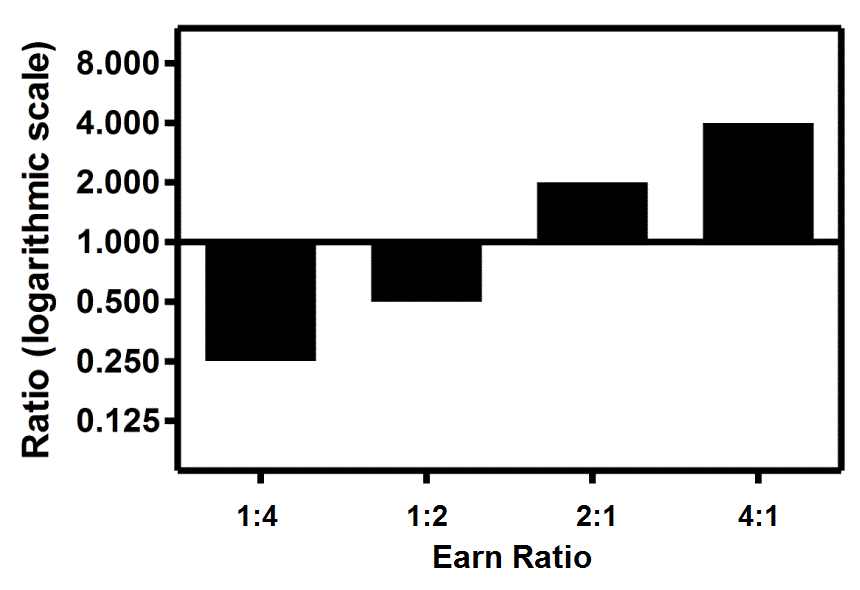Between a quick analysis of the United MP changes, and calling out the guilty parties (ourselves included) I happened to mention I’m a dual-earn dual-burn Milenomic. This was part of the discussion on Demand Schedules we worked on last week. This description was an example of my Earn ratio, which as you’ll see is 2:2, reducing to 1:1.
Today we’ll get more in depth with Earn Ratios. We’ll learn what each of our ratios is–and go over tips, as well as pitfalls to avoid for each possible ratio.
What is Your Earn Ratio?
Identifying your Earn Ratio is simple:
Your Earn Ratio is the relationship between the number of people participating in earning your miles (earners), and the number of people using your miles to travel (burners).
Most of us who earn our own miles, and use our own miles to travel have a 1:1 Earn Ratio. Those of us with a spouse who’s against the whole miles and credit card spending will have a 1:2 Earn Ratio (lower still if you have kids). Someone who is earning miles with another person but only travels alone might have a 2:1 Earn Ratio. This is rare–but happens.
My Progression From 1:1 to 1:2 and Back
My mile earning and spending has transitioned quite a lot from the days when I was a single person, earning miles for my personal use, to a married person earning miles to use for two of us. When it was just me the game of earning miles was relatively easy:
a. Open Card, earn X Miles.
b. Open another card earn X miles
c. Use Miles from a. for 1 way trip, miles from b. for return
This was a 1:1 Earn Ratio (single-earn, single-burn). As soon as I got married I realized the game had gotten harder. I was now in a 1:2 Earn ratio (single-earn, dual-burn).
Using the same example as above but now under the 1:2 Earn ratio:
a. Open Card, earn X Miles.
b. Open another card earn X miles
c. Open 3rd and 4th cards, earn X Miles.
d. Try to figure out how to use miles from 4 programs for 2 people to travel together.
As you can see things got more complicated. In addition I was burning miles faster than I could earn them. I sped up my earning through Milenomics Mileage Runs, but the costs to do so also increased. And Finally, orphaned miles are easily collected with low Earn Ratios.
Your Earn Ratio Helps Level the Playing Field
Earn ratios are useful for many reasons. An important one is to be able to compare other people’s strategies to your own. You often hear or see someone online traveling the world on credit card signs ups–claiming travel is free. What you don’t see is that they’ve got 6 bluebird cards from their parents and grandparents, who also allow them to apply for credit cards in their names. They might be a very rare case: a 7:1 Earn Ratio. With a 7:1 Earn Ratio I could travel every week overseas in Business or first and not run out of miles.
Let’s come back down to earth for a minute. Comparing ourselves to someone with a Higher Earn Ratio than our own will only make us attempt things that we shouldn’t.
Find someone with your same Earn ratio–and craft your plan based on their strategies. Remember Milenomics is about building our own personal system of earning and burning. Our own personal system might look nothing like what you see on any blog (this one included). Knowing our Earn Ratio allows us to quickly identify someone earning at a rate we cannot comparably earn. In essence, a Earn Ratio allows us to quickly compare our situation to others’ and keep our eyes focused on what works for us.

Moving Up From Lower Earn Ratios
Probably the #1 question I’m asked by those with less than 1:1 Earn Ratios is: How do I get my Wife/Husband/GF/BF on board with miles and points?
We discussed this a little during our System of Accounts post. The basics are: Travel is great–but don’t push your luck. Having an argument about miles is not our goal. We need to know our SO’s limits and respect them. Using their SSN and applying for CCs is a great way to forever end not only your travel, but also your relationship.
A good way to start is to be open and honest–“I’d love for us to go to Fiji–but we don’t have enough miles right now. Lets go to the Caribbean instead?” I don’t give my wife a detailed accounting of our miles–but when we’re low I tell her we’re low, and we need to re-up one way or another.
Note: Many people (myself included in the past) recommend splurging and booking business class returns on a trip–and then mention to your partner that you could book more of these if your partner played along. Doing so is dangerous–it may mean all your flights no need to be in Business Class. While it might bring you back to a 1:1 Earn Ratio if it ups your demand for miles by more than the increased Earn Ratio can help you’re going backwards.
I’m happy to announce my wife and I quickly moved from a 1:2 back to 1:1. When we were first married I played the CCC in single player mode. This became very difficult as our travel needs and demands got larger. Fortunately my wife saw the light. I wouldn’t say she’s a Milenomic–but she does allow to apply every other quarter for her credit cards, and doesn’t have as much of a problem with my MMRs.
The Importance of a 1:1 (or better) Ratio
If you also have a 1:2 or lower Earn Ratio you should focus on getting back to 1:1 before you do anything else.
Sure you can churn your way to the miles you need–but credit card signups and having dual earning will make your travel cheaper and easier to attain than having to try to earn the miles you need for 2, 3 or 4 travelers all by yourself.
Smaller ratios mean a harder to reach goals, imagine pushing a box uphill; if the hill is steeper, you’re going to have to push a lot harder to get the box to move the same distance. Now imagine pushing that box along a flat plane. This is a 1:1 Earn Ratio–much easier. And finally, with a greater than 1:1 ratio the pushing is actually even easier still.
Earn Ratios and Milenomics
Your Earn ratio also ties into what type of traveler you are. A 1:2 Earn Ratio, #101 level traveler is a lot less worrying than a 1:2 #301 traveler. You can probably exist happily at 1:2 if you’re a #101, and maybe even as a #201. Go any farther and you’re pushing water uphill.
Milenomics isn’t just about earning miles. It is about earning miles the smartest way possible. What tips do you have for other Milenomics to try to bring your Earn Ratio back to 1:1? Share them in the comments






I’m probably at a 1:1.5 – my wife does her part, but she doesn’t travel on paid tickets nearly as often, nor do we play the CC game quite as hard for her.
Fortunately our earn:burn ratio is healthy (earning slightly faster than burning – so family members reap the rewards of the “excess inventory”)!
Jason I’m Fascinated by this: earning slightly faster than burning – so family members reap the rewards of the “excess inventory”
Is your travel paid by someone else or do you choose paid tickets for some other reason? I’m interested in the dynamic there–excess mileage inventory but flying paid tickets. Can DM on Twitter if want to keep it off the web.
One thing that you should note is your ability to increase your earning by being an elite member which offsets your expenditures. So getting a 100% bonus on your miles makes your earning 2X which then equals the expenditure of you and your spouse or 2:2.
p.s. Your scale is exponential, not logmarithmic – sorry, we engineers can’t help ourselves!